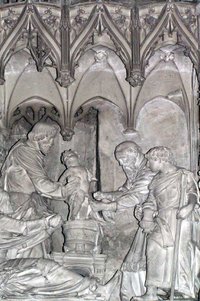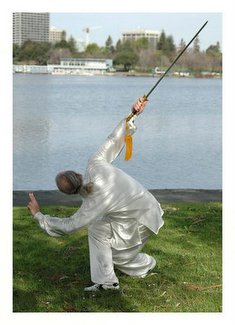I'm going to take it on the chin for this one.
In my ongoing efforts to illustrate atheists over the centuries, I have endeavored to keep to the positive spin, since we as a group have so many (imaginary) strikes against us.
However, with any group of people, there are always bad apples, folks we'd like to forget, or pretend never existed.
And, as I've mentioned before, I utterly despise the 'No true Scotsman' fallacy - and what is my motto boys 'n girls? Besides LOOK IT UP?
NO. FREE. PASSES.
Double standards absolutely suck the big hairy bird, if I might be so crude. Rules are rules - exceptions might be made for extraordinary circumstance, but they'd best be exceptional.
So I'm going to drag out of the history bins a black eye that no sunglasses can cover.
The Marquis de Sade:
Comte de Sade
The French writer of psychological and philosophical works Donatien Alphonse François, Comte de Sade (1740-1814), was also a libertine, debaucher,pornographer, and sadist - a term derived from his name.
The Marquis de Sade has been traditionally viewed as the greatest incarnation of evil that ever lived. Recently, however, new interpretations of his life and writings have begun to appear. It is now generally agreed that despite his reputation, his works, which were ignored for over a century, must be considered as of the first rank. Sade has been termed the "most absolute writer who has ever lived."
Born on June 2, 1740, to Marie Elénore de Maille de Carman, lady-in-waiting to and relative of the Princess de Condé, and Jean Baptiste Joseph François, Comte de Sade, who traced his ancestry to the chaste Laura of Petrarch's poems, the Marquis de Sade may be the most typical and the most unusual representative of the other side of the Enlightenment, the side at which the philosophes railed.
Very little is known of Sade's life. He graduated from the Colle‧ge de Louis le Grand, was commissioned as a coronet in the French army, and later sold his commission. He was forced to marry the eldest daughter of a leading magisterial family, Renée Pélagie de Montreuil, who bore him three children. Because of his libertinage, which included the seduction of and elopement with his wife's sister, Anne Prospe‧re, he incurred the unending enmity of his mother-in-law, who eventually had him imprisoned in 1781. Sade had tasted imprisonment before for libertinage and indebtedness, and he spent half of his adult life in prisons and asylums. Only three public scandals can be proved against him, and none of these seems to merit the punishment meted out to him, reinforcing his claim that he was an unjust victim of his reputation and others' hatreds.
During the Revolution, Sade was released from prison, served as secretary and president of the Piques section of Paris, and represented it at least once before the National Convention, where he addressed a pamphlet calling for the abolition of capital punishment and the enfranchisement of women. His attitudes and actions gained the hatred of Maximilien de Robespierre, who had him imprisoned (1793). He was saved only by the death of the "Incorruptible." Released in 1794, Sade was arrested in 1801 for being the supposed author of a scandalous pamphlet against Napoleon. He spent the rest of his life at Charenton insane asylum, where he died on Dec. 8, 1814. His best-known books include Justine; ou, Les Malheurs de la vertu (1791) and its sequel, Histoire de Juliette; ou, Les Prospérités du vice (1797).
Thus the life of the Marquis de Sade. Who was he? Why did he acquire the unique reputation he possesses? There are no simple answers regarding the life of any man. For Sade, there is possibly no answer at all. Recent works on his life have justly sought answers in his literary works, and because of this most commentators tend to psychoanalyze him. Although many of these works have offered brilliant insights into the character of the man, none of them is definitive and most treat him out of context, as though his life and aberrations were apart from life. Most Sadean scholars tend to agree that his hostility to religion, to the established social and political order, and to the despotism of existing law was similar in many ways to that of the philosophes. Some writers believe that he carried the beliefs of the philosophes to the rational conclusions, which in the end negated the conclusions and opened for succeeding generations a moral abyss. Others focus on what is termed a philosophy of destruction found in Sade's writings. Sade's atheism is viewed as the first element in a dialectic which destroys divinity through sacrilege and blasphemy and raises to preeminence an indifferent and unfolding nature which destroys to create and creates to destroy. Nature itself is then destroyed by being constantly outraged because it takes on the same sovereign character as God. What emerges is the "Unique One," the man who rises above nature and arrogates to himself the creative and destructive capacities of nature in an extreme form, becoming solitary, alone, unique in the conscious awareness that he is the creative force and all others are but the material through which his energy is expressed.
I find myself somewhat...ambivalent after having read that. I don't share the nihilistic sentiment, but it very much sounds like the man's been maligned in a caricature that's been perptuated over the years. Indeed, the name has (as has been inferred) been associated with unadulterated evil for centuries. As is usual, the facts are often at odds with the rumor. He even rates a brief mention in Barker's Hellraiser (the book, not the multiple movies).
In fact, let's take a closer look at some of his more (in)famous works:
Les 120 Journées de Sodome, written in the Bastille in 1784-5, was first published in 1904. The definitive text was produced in 1931-5 by Maurice Heine, whose work facilitated the passage of Sade's writing from the literary underground to open availability to creative writers (the Surrealists, for example, were already provided with Apollinaire's 1909 anthology of Sade) and scholars in psychology, literary history, and literary criticism. (The appearance in 1990 of the first volume of the Pléiade edition of Sade's complete works marks, as its editors say, the final admission of Sade into the university.) The 120 Journées, which presents the most forbidden subjects in uncensored detail, has not lost its power to shock; it is like a parody of the operations of the well-run modern state: a careful categorization of crimes and perversions, carried out to a strict timetable and set of rules by a brilliantly caricatured group of contemporary authority figures—judges, financiers, churchmen. The institutions of the state thrive in the spaces of individual despotic desire: in the private depths of the family castle, the bodies of the family and the paid servants are the raw material on which tyranny practises.
I suppose I'll have to read it: I've not read anything of Sade's, except a dim memory of the graphic novel of the following (which I put aside in distaste):
Justine ou les Malheurs de la vertu (1791; an expanded version of a text of 1787) is a less hair-raising version of the same theme of the pleasure and power of evil. In this first-person narrative, which inevitably—perhaps in deliberate parody—invites comparison with Voltaire's Candide, the naïve orphan, seeking only to live by an ethic of virtue and kindness, experiences a painful initiation into the logic of a Hobbesian universe. Subjected to a sequence of spectacular rapes and perverted cruelties at the hands of her fellow men and women, Justine, unlike Candide, is denied the chance of a happy ending by a well-aimed, morally indifferent bolt of lightning. In contrast, Justine's sister Juliette, a paradigm of evil, thrives and prospers (La Nouvelle Justine, ou les Malheurs de la vertu, suivie de l'Histoire de Juliette, sa sœur ou les Prospérités du vice, 1797). Juliette, having served and survived her apprenticeship with the most wicked libertines in France, takes off on an early Cook's Tour, spreading death, disease, and immorality through all the antique sites and beauty spots of Western Europe, devastating the cultural inheritance.
Sounds like a wild read.
Aline et Valcour, begun in the Bastille and finally published in 1795, had the merit, according to Sade, of predicting the Revolution, in the scattered references throughout the text to democratic principles and especially in its section on the Utopian kingdom of Zamé. In fact, the centre of the novel is the pleasure of incest: the baron de Blamont and his libertine friends engage in a complex seduction and exchange of daughters, closing the circle of desire.
Small wonder, that he wasn't so popular, n' est-ce pas?
Of the three aforementioned scandals he was convicted of, all three of them are exceedingly disgusting:
This first of his many incarcerations resulted from the violence he meted out to the young Jeanne Testard, whom he had paid to spend the night with him in small rented quarters in Paris which, like a number of aristocrats, the marquis kept for occasional trysts. During his encounter with Testard, the marquis first asked the young woman whether she believed in God, and then proceeded to desecrate a number of crucifixes and other religious objects. He asked the young woman to beat him with a red-hot whip and pressed her to choose the whip with which he would flagellate her.
Uggh! Along with marrying his aunt, and his pedophiliac affiair with a very young teenager in his dotage. Consider my ambivalence utterly demolished.
An unsavory character was the Marquis, filled to the brim with depravity, obviously incapable of anything remotely resembling self-control.
As to his ability with the written word, I will forbear judgment until having listened to his voice.
Quotes:
"Dread not infanticide; the crime is imaginary: we are always mistress of what we carry in our womb, and we do no more harm in destroying this kind of matter than in evacuating another, by medicines, when we feel the need."
"Wolves which batten upon lambs, lambs consumed by wolves, the strong who immolate the weak, the weak victims of the strong: there you have Nature, there you have her intentions, there you have her scheme: a perpetual action and reaction, a host of vices, a host of virtues, in one word, a perfect equilibrium resulting from the equality of good and evil on earth."
"There is no God, Nature sufficeth unto herself; in no wise hath she need of an author."
"Your body is the church where Nature asks to be reverenced."
"Never lose sight of the fact that all human felicity lies in man's imagination, and that he cannot think to attain it unless he heeds all his caprices. The most fortunate of persons is he who has the most means to satisfy his vagaries."
"The primary and most beautiful of Nature's qualities is motion, which agitates her at all times, but this motion is simply a perpetual consequence of crimes, she conserves it by means of crimes only."
"Get it into your head once and for all, my simple and very fainthearted fellow, that what fools call humanness is nothing but a weakness born of fear and egoism; that this chimerical virtue, enslaving only weak men, is unknown to those whose character is formed by stoicism, courage, and philosophy."



















